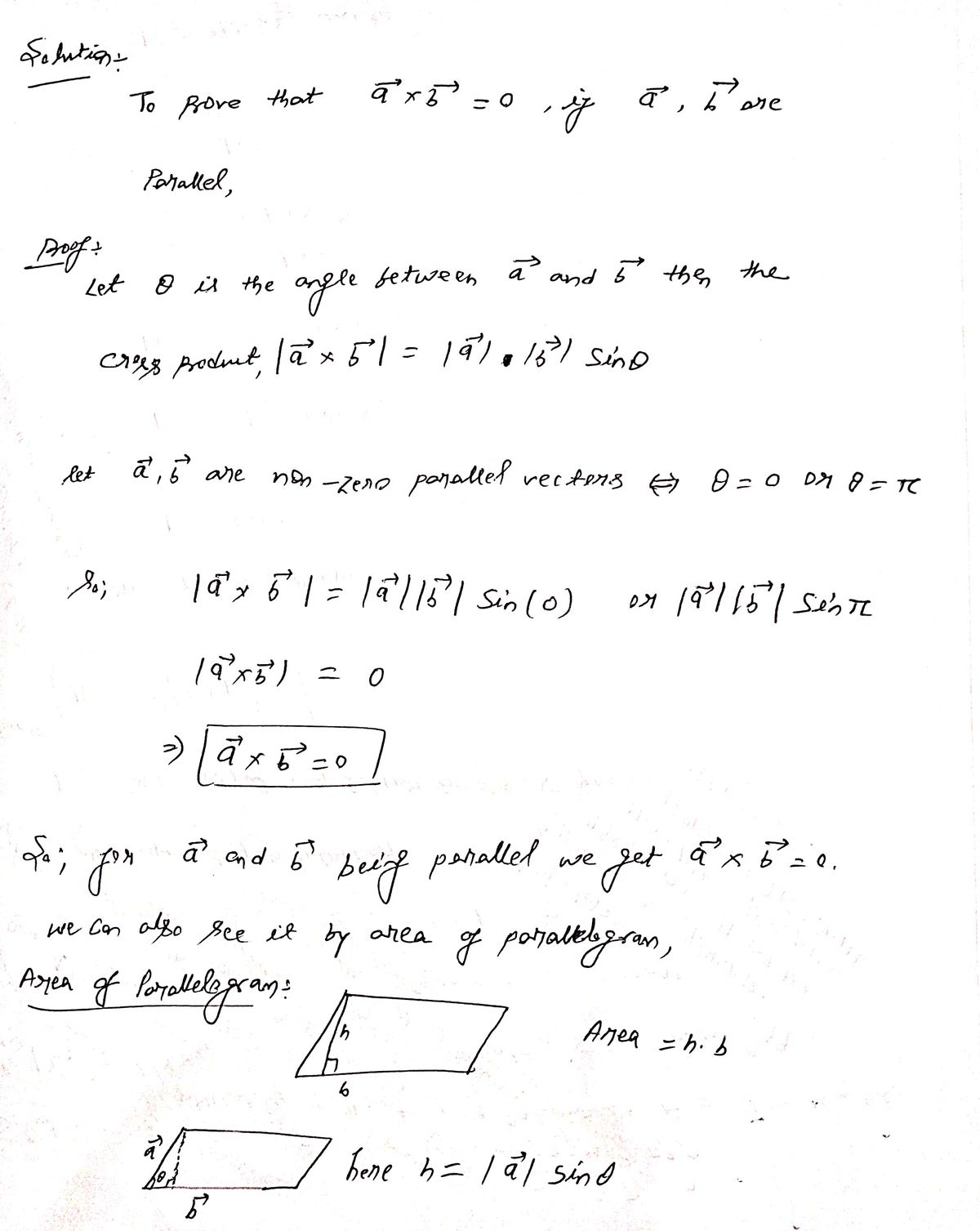Prove that if the vectors a,b parallel, then āxb=0. are %3|
Advanced Engineering Mathematics
10th Edition
ISBN:9780470458365
Author:Erwin Kreyszig
Publisher:Erwin Kreyszig
Chapter2: Second-order Linear Odes
Section: Chapter Questions
Problem 1RQ
Related questions
Question
![**Proof: If Vectors \(\vec{a}\) and \(\vec{b}\) are Parallel, then \(\vec{a} \times \vec{b} = 0\)**
Vectors are parallel if one is a scalar multiple of the other. This means that \(\vec{a} = k\vec{b}\) for some scalar \(k\).
The cross product of two vectors \(\vec{a}\) and \(\vec{b}\) is defined as:
\[
\vec{a} \times \vec{b} = \|\vec{a}\| \|\vec{b}\| \sin\theta \, \vec{n}
\]
where:
- \(\|\vec{a}\|\) and \(\|\vec{b}\|\) are the magnitudes of vectors \(\vec{a}\) and \(\vec{b}\),
- \(\theta\) is the angle between \(\vec{a}\) and \(\vec{b}\),
- \(\vec{n}\) is the unit vector perpendicular to the plane containing \(\vec{a}\) and \(\vec{b}\).
If \(\vec{a}\) and \(\vec{b}\) are parallel, then \(\theta = 0^\circ\) or \(180^\circ\). Thus, \(\sin\theta = \sin 0^\circ = 0\) or \(\sin 180^\circ = 0\).
Therefore, the cross product becomes:
\[
\vec{a} \times \vec{b} = \|\vec{a}\| \|\vec{b}\| \cdot 0 \cdot \vec{n} = 0
\]
This proves that if vectors \(\vec{a}\) and \(\vec{b}\) are parallel, then the cross product \(\vec{a} \times \vec{b}\) is indeed zero.](/v2/_next/image?url=https%3A%2F%2Fcontent.bartleby.com%2Fqna-images%2Fquestion%2Fbc9abf9e-d0b2-4cd9-9b4b-ff6d79921a6b%2F4e2fd8ac-3266-4bce-a4e1-b693c06f77d9%2Ffosqkxb_processed.jpeg&w=3840&q=75)
Transcribed Image Text:**Proof: If Vectors \(\vec{a}\) and \(\vec{b}\) are Parallel, then \(\vec{a} \times \vec{b} = 0\)**
Vectors are parallel if one is a scalar multiple of the other. This means that \(\vec{a} = k\vec{b}\) for some scalar \(k\).
The cross product of two vectors \(\vec{a}\) and \(\vec{b}\) is defined as:
\[
\vec{a} \times \vec{b} = \|\vec{a}\| \|\vec{b}\| \sin\theta \, \vec{n}
\]
where:
- \(\|\vec{a}\|\) and \(\|\vec{b}\|\) are the magnitudes of vectors \(\vec{a}\) and \(\vec{b}\),
- \(\theta\) is the angle between \(\vec{a}\) and \(\vec{b}\),
- \(\vec{n}\) is the unit vector perpendicular to the plane containing \(\vec{a}\) and \(\vec{b}\).
If \(\vec{a}\) and \(\vec{b}\) are parallel, then \(\theta = 0^\circ\) or \(180^\circ\). Thus, \(\sin\theta = \sin 0^\circ = 0\) or \(\sin 180^\circ = 0\).
Therefore, the cross product becomes:
\[
\vec{a} \times \vec{b} = \|\vec{a}\| \|\vec{b}\| \cdot 0 \cdot \vec{n} = 0
\]
This proves that if vectors \(\vec{a}\) and \(\vec{b}\) are parallel, then the cross product \(\vec{a} \times \vec{b}\) is indeed zero.
Expert Solution
Step 1

Step by step
Solved in 2 steps with 2 images

Recommended textbooks for you

Advanced Engineering Mathematics
Advanced Math
ISBN:
9780470458365
Author:
Erwin Kreyszig
Publisher:
Wiley, John & Sons, Incorporated

Numerical Methods for Engineers
Advanced Math
ISBN:
9780073397924
Author:
Steven C. Chapra Dr., Raymond P. Canale
Publisher:
McGraw-Hill Education

Introductory Mathematics for Engineering Applicat…
Advanced Math
ISBN:
9781118141809
Author:
Nathan Klingbeil
Publisher:
WILEY

Advanced Engineering Mathematics
Advanced Math
ISBN:
9780470458365
Author:
Erwin Kreyszig
Publisher:
Wiley, John & Sons, Incorporated

Numerical Methods for Engineers
Advanced Math
ISBN:
9780073397924
Author:
Steven C. Chapra Dr., Raymond P. Canale
Publisher:
McGraw-Hill Education

Introductory Mathematics for Engineering Applicat…
Advanced Math
ISBN:
9781118141809
Author:
Nathan Klingbeil
Publisher:
WILEY

Mathematics For Machine Technology
Advanced Math
ISBN:
9781337798310
Author:
Peterson, John.
Publisher:
Cengage Learning,

